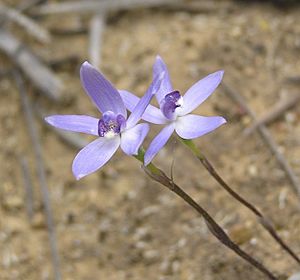Dainty blue china orchid facts for kids
Quick facts for kids Dainty blue china orchid |
|
|---|---|
 |
|
| Caladenia amplexans growing near Burracoppin | |
| Scientific classification | |
| Genus: |
Caladenia
|
| Species: |
amplexans
|
| Synonyms | |
|
|
The Caladenia amplexans, also known as the dainty blue china orchid, is a special plant. It belongs to the amazing orchid family. This orchid is endemic, meaning it only grows naturally in Western Australia.
It has a wide, flat leaf. This leaf often lies flat on the ground. The plant usually grows one or two pale blue and white flowers. What makes it unique? The sides of its labellum (which is like a lip) curve over the flower's column. They almost touch! This orchid also grows more inland than two similar blue orchids.
Contents
What Does the Dainty Blue China Orchid Look Like?
The Dainty Blue China Orchid is a plant that grows from the ground. It is a perennial herb, meaning it lives for many years. It has an underground tuber, which is like a storage root. Each plant has one flat, hairy leaf. This leaf can be about 4 to 10 centimetres (1.6 to 3.9 inches) long. It is also about 6 to 10 millimetres (0.24 to 0.39 inches) wide.
One or two pale blue and white flowers grow on a stalk. This stalk can be 12 to 25 centimetres (4.7 to 9.8 inches) tall. Each flower is about 2 centimetres (0.79 inches) long and wide.
Flower Parts Explained
- The dorsal sepal is the top part of the flower. It stands mostly upright. It is about 8 to 15 millimetres (0.31 to 0.59 inches) long.
- The lateral sepals are the two side parts. The petals are also similar in size.
- The labellum is the flower's lip. It is about 5 to 7 millimetres (0.20 to 0.28 inches) long. It is also 6 to 8 millimetres (0.24 to 0.31 inches) wide. This part is dark blue. It has fine, darker lines and spots.
- The sides of the labellum curve upwards. They surround the column, which is the central part of the flower. They almost touch each other.
- The labellum has a short, triangular tip. This tip curves downwards. It has about five small teeth on each side.
- There are two rows of cream-coloured calli (small bumps) along the middle of the labellum.
- These beautiful orchids usually bloom from August to early October.
How the Dainty Blue China Orchid Got Its Name
The Dainty Blue China Orchid was first officially described in 1984. This means it was formally named and recorded. The person who described it was a scientist named Alex George. He found the first example, called the type specimen, near Wubin. The description was then published in a science journal called Nuytsia.
Later, in 2000, two other scientists, Stephen Hopper and Andrew Brown, changed its name to Cyanicula amplexans. But in 2015, after more studies using molecular phylogenetics (which looks at plant DNA), the name was changed back. It is now once again called Caladenia amplexans.
The second part of its name, amplexans, is a Latin word. It means "encircling" or "embracing." This name was chosen because of how the labellum (lip) of the flower wraps around the column.
Where the Dainty Blue China Orchid Lives
You can find Caladenia amplexans in a large area of Western Australia. It grows from Norseman in the south to north of Kalbarri. It likes to grow in drier places. These include the edges of salt lakes and rocky hills.
Is the Dainty Blue China Orchid Protected?
The Western Australian Government Department of Parks and Wildlife has looked at the Dainty Blue China Orchid. They have classified it as "not threatened." This means it is not currently at risk of disappearing.

